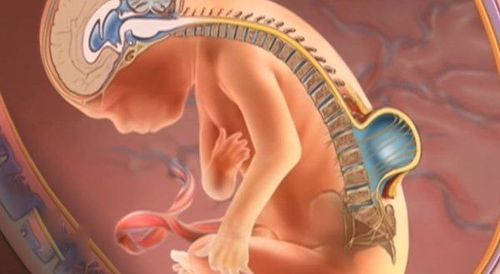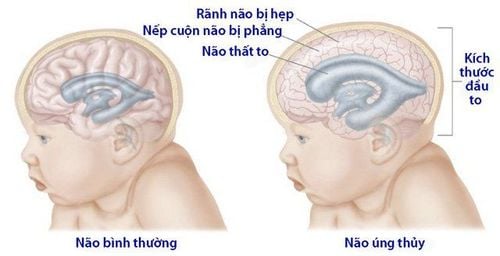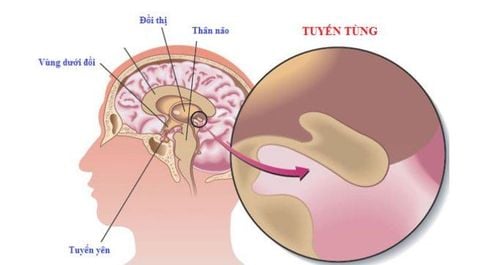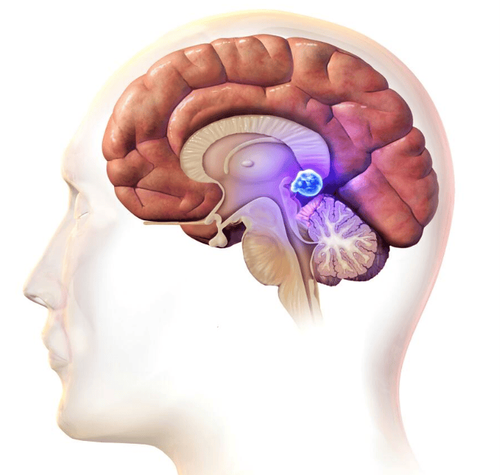This is an automatically translated article.
Pineal gland tumor is a tumor located in this region, including tumors of the pineal gland and tumors of the components and structures of this region. Tumors of the pineal gland can compress the third ventricle, compress the cerebral aqueduct causing hydrocephalus, compress the upper brain stem, compress the cerebellum, compress the posterior fossa... causing various disorders.
1. What is a pineal gland tumor?
The pineal gland is a small endocrine gland located in the vertebrate brain near the center of the brain that helps regulate circadian rhythms.Pineal gland tumor is a tumor located in this area, including tumors of the pineal gland and tumors of the components and structures of this area. Tumors of the pineal gland can compress the third ventricle, compress the brain drain causing hydrocephalus, compress the upper brain stem, compress the cerebellum, compress the posterior fossa... causing various disorders.
Pineal gland tumors account for about 0.4-1% of brain tumors, more common in Asians, accounting for about 3-9% of total intracranial tumors. The pineal gland is an anatomically complex region, located deep in the brain parenchyma, surrounded by many blood vessels and other important structures, so surgical access to this area remains a challenge for many surgeons.
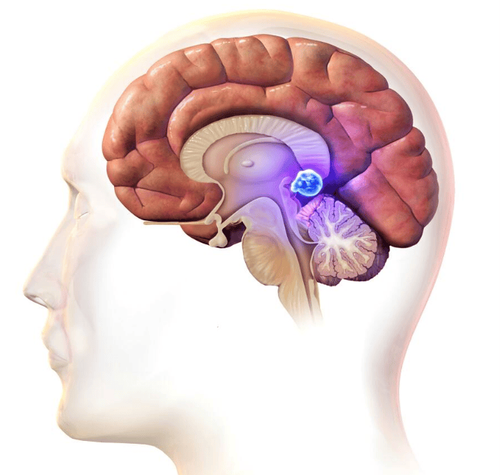
U tuyến tùng gây ảnh hưởng đến cuộc sống người bệnh
Pineal gland tumors can be divided into the following 4 types:
Pineal gland tumors Tumors of germ cell origin Glioblastomas Meningiomas
2. Manifestations of pineal gland tumors
2.1. The syndrome of increased intracranial pressure is caused by a tumor that blocks the circulation of cerebrospinal fluid, causing abnormally high intracranial pressure. The disease has a silent onset, so it sometimes causes only simple hydrocephalus and is easily confused with common hydrocephalus. Symptoms caused by increased intracranial pressure in this disease are headache, nausea, vomiting, and dyspnea. Therefore, the disease is sometimes mistaken for digestive disorders and common food poisoning. Signs distinguishing it from other syndromes: When intracranial pressure is increased, patients often have Cushing's syndrome manifested by bradycardia, increased blood pressure, and dyspnea.

U tuyến tùng gây ra hội chứng tăng áp lực nội sọ
2.2. Vision disorders Caused by the tumor pressing on pieces of white matter in the brain. Symptoms of the disease manifest through blurred vision, double vision, difficulty raising the eyes, loss of focus on 2 eyeballs (manifested by the patient's inability to focus the eyeballs to look at an object from a distance moving to the base of the nose; this is called the sign of the disease). Parinaud brand). Signs of difficulty concentrating, personality disorders, mental disorders, loss of coordination, endocrine disorders due to tumor compression of surrounding structures or invasion of structures adjacent to the pineal gland.

U tuyến tùng gây rối loạn nhìn
2.3. Other clinical symptoms If it is a pineal gland tumor, the patient often presents with a chronic headache.
If the malignancy develops rapidly, the patient may present with an acute clinical presentation, rapid deterioration of consciousness, or coma.
If the malignant tumor follows the cerebrospinal fluid to the spinal cord, it can cause symptoms of back pain, pain in the back of the neck. If a tumor in the pineal gland (usually germ cell tumor) invades the hypothalamus and pituitary gland, it will cause symptoms of diabetes insipidus, increase HCG levels and cause early puberty, usually before the age of 10 years. . Germ cell tumors are the most common childhood pineal gland tumors.
3. Diagnosis of pineal gland tumors
3.1. Quantitative AFP, HCG If there is a pineal gland tumor, usually the doctor will not operate immediately, except in urgent cases, can perform quantitative exploration of AFP, HCG, localized biopsy to determine the nature of the tumor. . Such investigations allow the identification of benign or malignant pineal gland cysts and are valuable in the treatment strategy because these tumors are curable with radiotherapy.
At the same time, quantification of AFP, HCG levels allows monitoring of treatment effectiveness (AFP, HCG levels gradually decrease when treatment is effective, do not decrease or increase when treatment is ineffective), allowing assessment of the possibility of treatment. recurrence of pineal gland tumors (AFP, HCG levels increase suddenly when they have decreased).

Định lượng AFP, HCG
3.2. Diagnostic imaging The most important imaging studies of pineal gland tumors are computed tomography (CT-Scan) and magnetic resonance imaging (MRI)
CT-Scan images are very valuable treatment in the diagnosis of pineal gland tumors. Tumors in this region often have intratumoral calcifications and strong contrast enhancement, concurrently compressing causing obstruction and dilation of the ventricles. MRI images are valuable in the diagnosis and prediction of anatomic lesions of pineal gland tumors. MRI images assess the size, morphology and invasion of the tumor; Assessing the relationship between the tumor and the ventricles and surrounding vascular structures helps the surgery, if any, to be more accurate and safer.
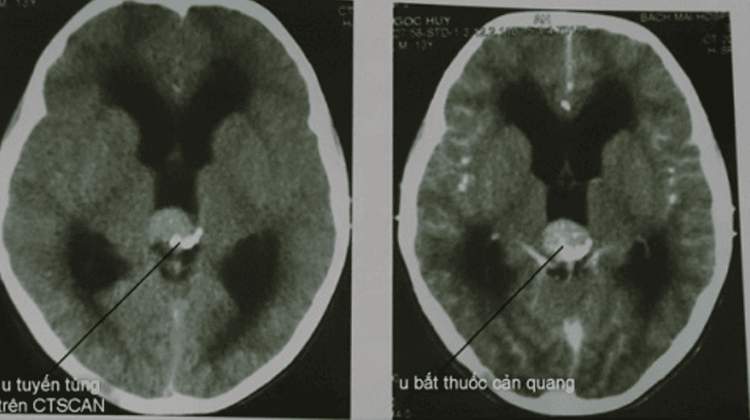
Kết quả CT-Scan u tuyến tùng
4. Direction of treatment of pineal gland tumor
Pineal gland tumors are mostly malignant (40%) but most are sensitive to radiation therapy. Benign pineal gland tumors are usually treated with surgery. If the patient has hydrocephalus, the hydrocephalus must be treated with endoscopic ventriculostomy or ventricular-abdominal drainage. If the patient does not have hydrocephalus or mild hydrocephalus is not dangerous, it is advisable to combine laboratory tests to know the nature of the pineal tumor. If the test results confirm that a germ cell tumor is present, radiation therapy is recommended. If the test results do not allow to conclude the nature of the pineal gland tumor, biopsy or surgical removal of the tumor should be performed. To register for examination and treatment at Vinmec International General Hospital, you can contact Vinmec Health System nationwide, or register online HERE.
MORE
How is hydrocephalus diagnosed? Dangerous complications of hydrocephalus Learn about testing cerebrospinal fluid to find the cause of headaches




